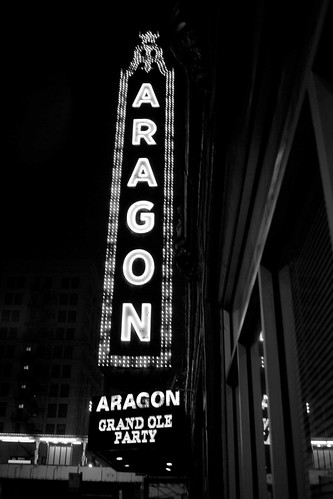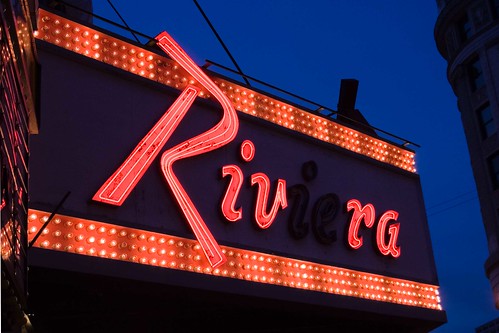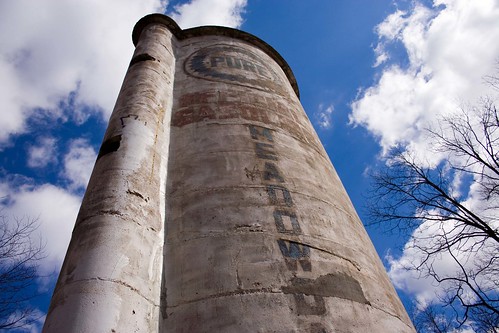The extravagantly decorated Aragon Ballroom opened in 1926, about a block away from the Riviera and Uptown. The first non-movie house on our little walk, the Aragon was an immediate hit, due in no small part to it's proximity to the L train, which to this day runs just past the west wall of the place. But it was a beautiful room, had a huge dance floor, and featured some of the Jazz Age's top acts.
The Aragon was a truly ornate space. On entering people were greeted with granite walls hung with tapestries, and a grand, thickly carpeted staircase leading to the second-level dance floor. Upstairs, patrons were greeted with palm trees and lights twinkling in the ceiling. Designed to resemble the courtyard of a Moorish castle, dancers were transported to another world, under clear Mediterranean skies.
It couldn't last. Massively popular through the 40's, and boosted by nightly broadcasts by WGN radio, the Aragon's regularly scheduled dance nights had all but ended by the 60's, usurped by television and rock concerts. Rock concerts, of course, are one of the things that the Aragon is most widely known for by many Chicagoans-a series of heavy rock acts played the room through the 70's and 80's, giving rise to the nickname "The Brawlroom", a moniker it carries to this day.
The Aragon is another one of those places that just oozes history. I can easily see the elegant dances of the twenties and thirties, filing up the stairs, gliding over the cavernous dance floor.
Thursday, September 30, 2010
Uptown, Pt. 3
Uptown, Pt. 2
Just up the street from the Uptown stands The Riviera, the second stop on our tour of Uptown's classic venues. Opened in 1918, the Riv was a 2,500 seat movie palace, and like the Uptown was designed by Rapp and Rapp and managed by Balaban and Katz. B&K posited the Riviera as an upscale theater, better than the cheapie nickel joints that dotted the city. Interestingly, the Riviera included not only the theater, but several storefronts along Racine and thirty-six apartments.
The Riviera showed movies until the 1970's, when it was converted to a concert venue. It's undergone changes, and is kind of shabby inside now, although it's not the absolute pit people sometimes say it is. But it's impressively original in places, too, and you can feel the history dripping from the chandeliers (or maybe that's just condensation-it gets hot in there). I've seen concerts here, but I can't quite imagine seeing a movie there-I imagine it must have been quite awesome, to be seated in this ornate Jazz-Age cathedral, uniformed ushers at the ready, watching a flickering screen.
I like passing the Riv, even when it's closed. I'm not sure why-I think it's simply because it's still there, and still operating. The Uptown Bank Building is still across the street, but it's the Bridgeview Bank now. The plastic cladding is gone from the storefronts next door. The awesome old Goldblatt's sign is gone from the building across Racine, a building that's been nicely restored to it's early condition. The tidy streets of Lakeview and Andersonville are slowly being replicated here in seedy old Uptown, and there's the Riviera, waiting for the next crowd to turn up.
Oh, I almost forgot. The Golden House next door? Same as it ever was.
Tuesday, September 28, 2010
Uptown, Pt. 1
Uptown, on the north side of Chicago, is an interesting neighborhood, and taken as a whole is a place of contradictions. It is at turns well kept and shabby, quiet and loud, workmanlike and elegant. It encompasses such diverse spaces as the suburban-esque houses of Buena Park and the tree lined streets of Margate, to the down at heel storefronts around Wilson and Argyle. But the spiritual center of Uptown is the entertainment district. It is by far my favorite part of Uptown, and one of my favorite places to walk through, day or night.
Spanning just a small area around the intersection of Lawrence and Broadway, the Entertainment District is a popular tourist destination, and was designated a National Historic District in 2000. Formerly home to several infamous theaters and nightclubs, only four remain, and only three of which are still a going concern.
Pictured is the Uptown Theatre, a grand movie palace designed by Rapp and Rapp and run for much of it's life by Balaban and Katz. It's large, having seats for over 4,000 patrons, and ornate, featuring some wonderful detailing inside and out. It is also in a state of arrested decay, with some of the exterior ornamentation having been removed for repair, plywood board covering the high windows, and steel poles holding up the marquee. It is now owned by a music production company that hopes to continue the restoration of this fine space, and reopen it as a music venue. I can only hope they succeed.
Occasionally, when I walk past, I'll see the front door open, some dim lights on in the lobby, and some work being done. I can see a brief glimpse of the ornate interior of this grand old palace and I wonder. I wonder what it was like to walk up to the Uptown on a Friday night, marquee ablaze, crowds on the sidewalk, and buy a ticket.
It is something I can only imagine.
Meadowdale
Meadowdale Raceway stood-stands, really, since it's still there-in suburban Carpentersville. It hosted all manner of sports car racing for about a decade in the sixties before increasing debts and decreasing ticket sales caused the owners to close the gates for the last time. Gone were the cars and noise, the spectacle, the fun. Amazingly, the land lay fallow for decades, until the property was turned into a hiking area and forest preserve.
Hiking it is an eerie experience, even now that it's been cleared of garbage, and has some amenities like benches and shelters. The track surface survives in many places*, and you can follow it most of the way around. Down the banked Corkscrew, uphill through the esses, all along the signature mile-long straightaway. All of this winds through the woods, leafy maples crowding the old, cracked pavement, pines dotting the infield. It's beautiful, but haunting, and one can almost hear the engines.
Period photos show a fully built up facility, with concession stands, a timing tower, bleachers, marshal posts, and billboards. None of this exists anymore, the victims of time, weather, and vandalism. A pile of rubble is all that exists of a hot dog stand near the pits, and a concrete pad that once held a pair of Pure Oil gasoline pumps. A pair of telephone poles on the hill at the inside of Doane's Corner mark a marshal's stand. Wire fencing shows up here and there, buried in the trees. But otherwise, nothing.
Except the Silo. At the bottom of the track, just after the Corkscrew, stands the Pure Oil Silo. It has stood in this spot since before the war, when this area was all farmland. Painted white, with the Pure logo signwritten at the top, it became a landmark for the track, then and now. Today it stands faded and chipped, bearing mute witness to cyclists and dog walkers, rather than the roar of engines.
*There have been some changes at the track since I first wrote this. A paved bike path has been run over most of the course, however the original racing surface was removed to do so. This is most noticeable in the Corkscrew, and in the strip of new blacktop that runs up the long, long main straight. Also, the silo has been repainted. Fortunately, it was restored to it's Meadowdale livery. While I liked the patina of the old paint, I appreciate that the park district went to the effort to preserve this bit of history. See the restored silo here.
Monday, September 27, 2010
Gimme Fifty Cents' Worth Of Regular
As promised, something new(ish).
This little gem is the historic Standard station in Odell, Illinois, and sits right along old Route 66. Opened in 1932, the station served travelers along the Mother Road until the sixties, by which time a bypass had taken travelers around the retail strip in Odell, and Rt. 66 itself was in a steady decline, losing traffic to the interstates and airlines. The station continued in business until 1999, doing repairs and bodywork, at which point the city bought the property with the intent to restore the building to it's original 1932 style. This they have done, and it serves as a visitors center along historic Route 66. It is beautifully done.
You may ask, Doug, why does this photo look all crummy and out of focus? Don't you have a fancy digital camera? The truth is yes, I do, and I did it on purpose. I shot this through the viewfinder of an old Spartus Full-Vue TLR camera, to get the distortion and dust, for that vintage, found in a shoebox look I like to call "Oldachrome". Did I succeed? Dunno. But I like it.
A return.
I'll have a real post-with a picture even!-in a bit.




